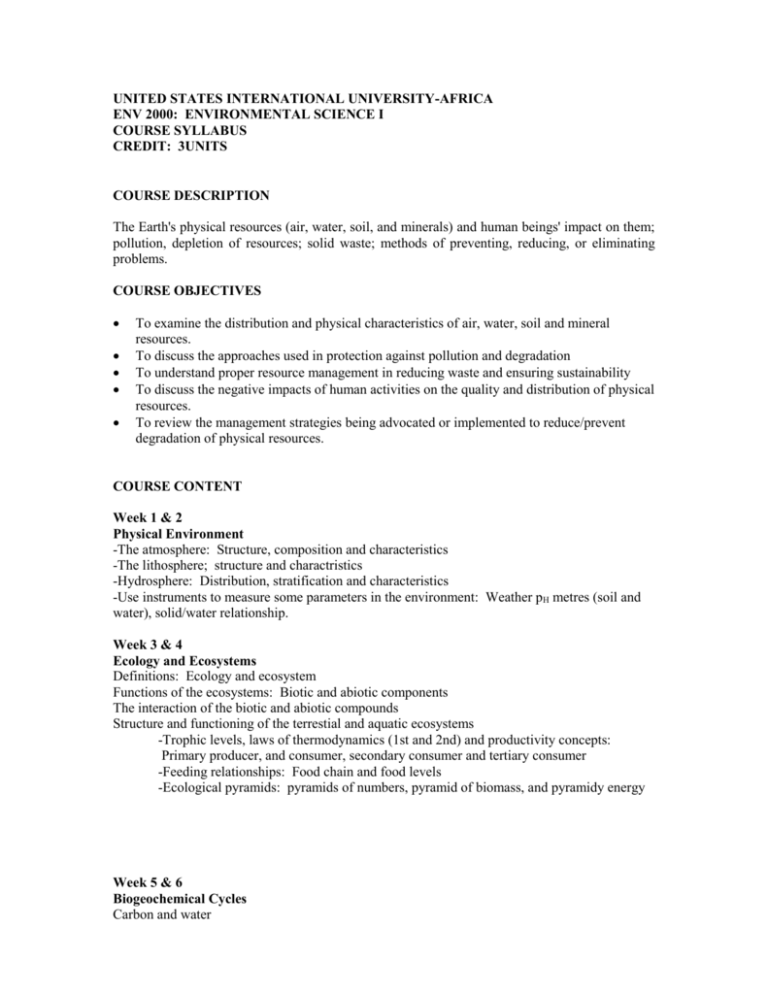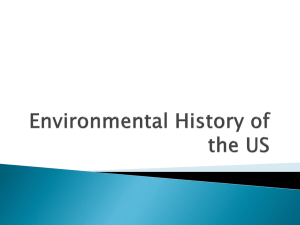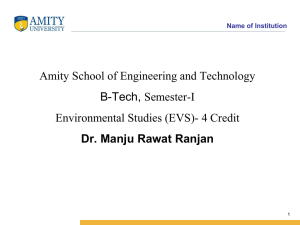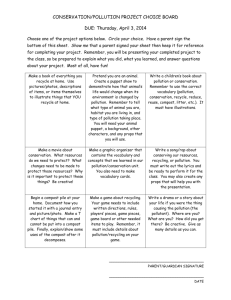ENV2000
advertisement

UNITED STATES INTERNATIONAL UNIVERSITY-AFRICA ENV 2000: ENVIRONMENTAL SCIENCE I COURSE SYLLABUS CREDIT: 3UNITS COURSE DESCRIPTION The Earth's physical resources (air, water, soil, and minerals) and human beings' impact on them; pollution, depletion of resources; solid waste; methods of preventing, reducing, or eliminating problems. COURSE OBJECTIVES To examine the distribution and physical characteristics of air, water, soil and mineral resources. To discuss the approaches used in protection against pollution and degradation To understand proper resource management in reducing waste and ensuring sustainability To discuss the negative impacts of human activities on the quality and distribution of physical resources. To review the management strategies being advocated or implemented to reduce/prevent degradation of physical resources. COURSE CONTENT Week 1 & 2 Physical Environment -The atmosphere: Structure, composition and characteristics -The lithosphere; structure and charactristics -Hydrosphere: Distribution, stratification and characteristics -Use instruments to measure some parameters in the environment: Weather pH metres (soil and water), solid/water relationship. Week 3 & 4 Ecology and Ecosystems Definitions: Ecology and ecosystem Functions of the ecosystems: Biotic and abiotic components The interaction of the biotic and abiotic compounds Structure and functioning of the terrestial and aquatic ecosystems -Trophic levels, laws of thermodynamics (1st and 2nd) and productivity concepts: Primary producer, and consumer, secondary consumer and tertiary consumer -Feeding relationships: Food chain and food levels -Ecological pyramids: pyramids of numbers, pyramid of biomass, and pyramidy energy Week 5 & 6 Biogeochemical Cycles Carbon and water Phosphorus and nitrogen cycles Population dynamics and carrying capacity: Biological potential and environmental resistance Ecological succession: Primary and secondary Week 7 The Earth’s Physical Resources Definition of natural resource, examples and categorization Kenya’s most valuable resources and their management -Air: Importance, current state and corrective measures being taken -Soil: Value, current state, and conservation efforts including land act cap 303, and Agricultural Act Cap. 318. -Water: Water apportionment board, water act Cap. 372 -Mineral: Value, current state and conservation efforts MID QUARTER EXAMINATION Week 8 Solid wastes and Pollutions Definitions Sources and generation of the type of waste Impact on physical resources Strategies for management of each of the waste Pollution: types, causes, effects, and reduction methods Week 9 Environmental Health Concepts of good health: Physical, mental, and social well being Causes of poor health and their effects -Poor sanitation and poor nutrition -Common environmental diseases: Waterborne (e.g. Cholera and typhoid); water-related vector -Communicable diseases, STD(s), AIDS etc. Environmental hazards - Natural hazards -Chemical health hazards: Heavy metal poisoning e.g. Cadmium, Lead, Mercury etc. -Agro-chemicals -Drug misuse and abuse, Drug Act Cap. 245. -Radiations electromagnetic solar -Natural disasters: Climate, Geological and Biotic (e.g. desert) Ways of promoting good health through locust invasion environment -Promotion of adequate and clean water, sanitation facilities -Destruction of habitats of disease pathogens, and vectors -Maintaining cleanliness and beauty of the environment -Reducing effects of environmental hazards Week 10 Strategies for Conservation of Resources World conservation strategy 1980: -Maintaining essential ecological processes and life supporting systems -Preserving genetic diversity -Sustainable use of species and ecosystems and reduction of waste Caring for earth -Conserving earth’s vitality and diversity -Minimizing the depletion of non-renewable resources and their degradation -Keeping within the earth’s carrying capacity -Protection against pollution International conventions: -Vienna convention (1985) on protection of ozone layer -Montreal protocol, (1987) on reduction of ozone depleting substances Week 11 Food and Nutrition Food in Kenya: Sources, methods of production (farming) and consumption patterns Nutritional value of food: -Balanced diet and deficiency diseases -Supplement/alternative sources of food nutrients Week 12 Energy and Technology Sources of energy, forms and transformation: -Non-renewable sources of energy: Coal, oil and natural gas (fossil tyros) -Related technologies of exploiting non-renewable sources of energy and impact on environment Renewable sources of energy and their technologies: Solar panels, geothermal and nuclear reactors Strategies for the conservation of energy: -Use of energy conserving devices -Efficient use of energy -Use of diverse sources of energy Food and storage and preservation: Traditional and modern methods Problems associated with food storage and preservation -Food loss -Food contamination -Possible solutions to his Kenya national food policy Week 13 Desertification Definition, process and trends of Desertification Causes and consequences of desertification: -Natural and Man-made causes; -Consequences include: Loss of genetic resources reduced agricultural productivity and siltation of dams Efforts to combat desertification -Afforestation -Re-afforestation -Agroforestry -Soil and water conservation methods -Appropriate agricultural practices -Levels of operation to combat desertification: Individual, local, national, regional and international Week 14 FINAL EXAMINATION TEACHING METHODOLOGY Lectures and demonstrations Classroom discussions Take-home assignment Term-paper, mid-term tests, final examination COURSE TEXT G. Tyler Miller, Living in the Environment (2000) 11th Edition (Belmont: Wadsworth Pub. Co.) READINGS Boughey, S.A, Man and Environment: An Introduction to Human Ecology and Evolution (New York: Mcmilan Publishing , 1975) Otiende, J. E. et. al , An Introduction to Environmental Education(Nairobi: Nairobi University Press, 1991) Dasman, R. F., Environmental conservation (New York: John Willey & Sons, 1984) Elson, D., Atmospheric Pollution: Causes, Effects and Control Policies (Oxford: Blackwell, 1987) United Nations, Environmental Issues, Population, Pollution and Economics (New York: Norton & Company, 1972) Moran, J.M et al, Introduction to Environmental Science (San Francisco: Freeman, 1980) Dix, H.M, Environmental PolLution: Atmosphere, Land, Water and Noise (London: John Willey, 1981) Kupchella, Charles E. (1993), “Environmental Science: Living within the system of nature”, Prentice Hall/Eagle Wood Cliff, New Jersey. COURSE EVALUATION Class attendance and participation Term paper Quiz and class assignments Mid-quarter Exam Final 10% 15% 10% 20% 45% GRADING 90 - 100 A 87 - 89 A84 - 86 B+ 80 - 83 B 77 - 79 B74 - 76 C+ 70 - 73 C 67 - 69 C- 64 - 66 D+ 62 - 63 D 60-61 D0 - 59 F









